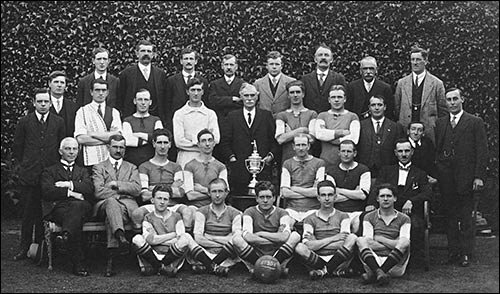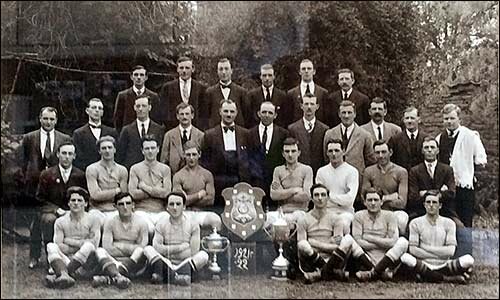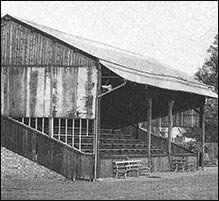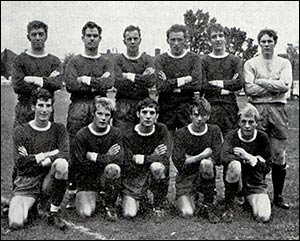|
|
||||||||||||||||||||||||||||||||||||||||||||||||||||||||||||||||||||||||||||||||||||||
| From a booklet published by the Club, 1971 |
||||||||||||||||||||||||||||||||||||||||||||||||||||||||||||||||||||||||||||||||||||||
|
Higham Town Football Club
|
||||||||||||||||||||||||||||||||||||||||||||||||||||||||||||||||||||||||||||||||||||||
|
50 Memorable Years 1920-21 to 1970-71
|
||||||||||||||||||||||||||||||||||||||||||||||||||||||||||||||||||||||||||||||||||||||
|
The Beginning
Higham Town Football Club was first formed as far back as the early 1890's. In 1893-94 it was one of the Clubs affiliated with the Northants F.A., and the first Secretary was Mr. J. Eaton of 15 Westfield, Higham Ferrers. During the next 3-4 years, the Club existed in some shape or form, with various Secretaries, but from the early 1900's to after the First World War it does not appear to have survived. However, in the 1920-21 season Higham Town F.C. was restarted under the first President of the Club, Mr. W. (Billy) Brown, who was a Dairy Farmer in the Borough, and who really worked tremendously hard to help put the footballers of Higham Town "on the map". It was in these early days that the nickname “LANKIES" was first coined. The first side used to play on a field belonging to the Duchy of Lancaster, and was called Lancaster Field. This name was shortened, and the name Lankies has stuck to the Club since those very first memorable days. The Golden Days The first years of the formation were to prove to be the halcyon days of Higham Town. Those were the days when they were second to only Northampton Town in the county.
They commenced in 1920-21 by finishing second in the Wellingborough & District League, and they were the winners of the Northants Junior Cup. In 1921-2, they entered the Northants League (now the United Counties League) and in their first season in the League, they emerged as Champions. They also had two other trophies on the shelf, those of the Northants Senior Cup and the Raunds Charity Shield. They also finished runners-up in the Irthlingborough Charity Cup.
In 1922-23, the next season, they won the Northants League again, and also the Maunsell Cup, which was then the highest Cup Competition in the County. They reached the final of the Rushden Charity Cup, and the semi-finals of the Northants Senior Cup. The remarkable achievement of winning the Junior Cup, Senior Cup and Maunsell Cup in three consecutive seasons must be a County record, and will certainly never be repeated. Also in 1922-23 Higham Town almost pulled off one of the greatest sensations football had ever known in the area. With 4 minutes to go they were leading 4-3 at Chesterfield, in the F.A. Cup, but Chesterfield equalised, and then won the replay at Higham, by 1-0. To reach that round, it is interesting to note that Higham Town knocked out Bedford Town, Spalding and Kings Lynn. Building the Stand All of this hair-raising stuff just would not have been possible if Billy Brown and all the other enthusiastic Committee men had not worked very hard to make the side one that any City, let alone Town, would have been proud of. To commemorate these first golden years, a Souvenir Programme was printed, with pen pictures of the players of the day. One or two names may bring back a few memories . . . Captain of the side . . . Alf Collins, centre half. . . Dick York, a dangerous centre forward . . . Billy Cadd, a winger of high repute . . . Dave Jones, a hard tackling full back . . . Horace Clarke, a very good wing half. . . . his brother Frank (Plum), a versatile forward with a shot in either foot . . . and Solly Upton, a tricky winger, also with Spurs and Portsmouth. Two more players who will be remembered are Peter Eaton, a forward with a fine turn of speed, and Fred (Cheddy) Smith, a fine full back. At 71, Fred Smith, nominated by many as the best player of that era still recalls the Chesterfield game and says, "We were one of the unluckiest teams in the Cup". In their cup run which took them to Chesterfield, Frank Clarke, better known as Plum, hit 10 goals in 12 games, including two at Chesterfield. During the 1922-23 season he notched 20 goals out of their 88 goals to put him second in the scorers list behind R. York who had 27 goals to his credit. Without a doubt, one of the club's characters in those days was Solly Upton, ex Spurs star, and a former Mayor of the Borough. He came to Higham after a great deal of persuasion from Billy Brown and George Goosey, the latter being a publican in Higham, and another man to whom the Club owed a great deal in those first years. It was Solly Upton who scored the winning goal in the Maunsell Cup against Northampton Reserves, and he is still immensely proud of the medal he received, “the only medal I have ever won” he says. Nevertheless, 50 years ago these players, with Solly in particular helped to bring fame and glory to Higham Ferrers.
However, these players were not playing when Higham Town scored their most memorable victory. in1934. In the final of the Maunsell Cup on their own ground and in front of over 2,000 people Higham destroyed Third Division South side NorthamptonTown. Higham had earned a place in the final after a 4-3win over Kettering Town. The Cobblers had just beaten Huddersfield Town, who were then top of Division One, in the FA Cup. So of course everyone expected a big Cup win at Higham for the Cobblers. But with 10 minutes to go it was 1-1. Then Higham's inside right, Webb, collected the ball. He ran forward and with the Cobblers defence filing back, expecting him to pass, he let fly, and the ball rocketed into the net. The crowd erupted, and Higham had won their greatest victory. After the Cobblers win over Huddersfield, and Higham’s subsequent win over the Cobblers Higham were christened "Kings of England". That team is still remembered fondly in Higham to this day: Freeman, Lambert, Johnson, Cowper (captain), Marks, Webster, Keech, Webb, Brown, Horn, Mickley. But sadly, just as the Club reached its peak, the bubble burst. The Fall The next season the Club folded and there was no team until 1946. It was the end of a golden age of football in Higham, that was never again to be repeated. Perhaps no-one realised that never again would the trophies come flocking to Higham. All that was left were the memories and ghosts of an age gone by. The players left the Club to seek fame and fortune elsewhere. George Webb, the scorer of that goal, went to Manchester United, only to return a few months later out of luck. He was not as fortunate as another ex-Higham player, Ernie Toseland, who left the Club and joined Coventry. Within a few months he had signed for Manchester City, and in the same year that Higham scored their Maunsell Cup victory, he won an F.A. Cup winners medal, with City. The Re-formation In 1946, after a gap of 11 years, the Club started once again as a purely amateur side, in the Rushden and District League, where they stayed until the formation of the Second Division of the United Counties League in 1950. During these early 1950's the Club was in the generous hands of their President, the late Mr. J. W. (Johnny) Barker. At his side were the other willing workers like "Hooker" Partridge, who was Chairman of the Club, Ron Newell, the Secretary, Fred Hilson, Treasurer still on the Committee today, and Dick Turnock, who has been associated with the Club since the very early days. The fifties were quiet years for the Club, with very little glory but always finishing consistently mid-way in the table. Twice the Club went to Peterborough in the Senior Cup, and twice they lost. However, as a consolation, George Swindin, then manager of the Posh, wrote to the Club, and congratulated them on the performance they put up. No luck came their way in the Amateur Cup either, as having beaten both Ramsey and Ely City, they earned themselves a trip to Cambridge City, but went down 4-0. But if the Club itself did not exactly set the county alight, they had plenty of crowd pleasing players. Like Andy Wilson from Eastbourne, one of the great characters of Higham in the 50's. "Jock" Watson, another player who made the grade with Derby. Both of these two are still actively connected with the Club today, as Committee members. There was a former Chairman and captain of the side, Don "Tiger" Loakes, a hard tackling defender, Steve Howe, at centre half, and Peter Houghton at full back. In goal, there was Roddy Walker, who earned himself the nick-name "the Cat". The Peterborough visit did have a happy outcome for Dave Ballard, as he later signed professional forms for Nottingham Forest. Another new face on the scene in the later 50's, and who became President of the Club, was Ron Whitney. During the 1960's Ron formed the mainstay of the Club's finances, and together with Ernie Horn, ran several fund-raising schemes for the very active Supporters Club that was in being during these years. Ron is still the President today, and with Albert Hackney they were the back-bone of the Club for many years.
The sixties marked the end of an era for the Club in one way when another Star of the 50’s, Albert Hackney, finished playing. However, he continued with the Club as Chairman, a position he holds to this day. Everyone knows the debt the Club owes to Albert as only too often the full work load fell on to his shoulders, and the fact that he did not flinch means we have a Club today. Soon after one era came to an end, so did another. The Grandstand which for so long had been part of the Higham ground was pulled down in 1966, to make way for the present £10,030 sports pavilion, which was officially opened by the then Minister of Sport under the Labour Government, Mr. Denis Howell, M.P. As the 60's drew slowly to their close, many familiar names appeared in Higham colours. There was Mick Dyte, now with Wellingborough Town; Chris Smith, now with Rushden; tough tackling Rodney Green, also at Rushden, and Gerry Bosworth, the Diamonds goal-keeper. In fact about three-quarters of the Diamonds Division One side of two years ago, were the products of the Higham Town "breeding ground". The late 60's also saw the retirement from the playing side of Brian Harbour, one of the best centre halves in the League, and who must have been Higham Town's longest serving player. He played for the Club for 15 seasons and is still very active in serving on the Committee. The Re-juvenation In February 1968 the Committee decided to make a determined effort to attempt to revive old fortunes, and lift themselves up the U. C. L. table. One decision was to appoint a Team Manager, and their first choice for season 1968-69 was Dave Wooding, a former captain of Wellingborough Town, and a respected name in local football. However, after one season, he parted company with the Club, and was replaced by the ebullient "iron man" George Gee, a former player with several Football League Clubs. He set to work on the Club, signed new players, re-juvenated the reserve side, and soon his influence on the side became felt. In his first season with the Club, 1969-70, Higham Town finished in sixth position, the best for many years. The Seventies and the Future In this 50th Anniversary Season, 1970-71, Higham Town have become noticed, and are no longer a side that could be relied upon to give away two easy points. In only his second season as Manager, George Gee has moulded a team together that Higham Ferrers can be proud of once again. The records prove that we are back "on the map". We have finished runners-up to Long Buckby, by far our best season since the war. 22 games were won out of the 34 played, and we scored exactly 100 goals to only 35 against. Stuart Sinfield netted a total of 41 goals and Dave White 25. Quite an achievement. First Division is just around the corner, but at the same time a world apart. It is a big step up to the Rushden's, Bourne's, and Diamonds . . . . can Higham do it? Will they get the chance? We shall have to wait a little longer to know the answers. One thing is certain, however, the Higham Town of the 70's will be a lot more interesting than the Higham Town of the last 20 years. As a post-script to the 50 years of memorable history, there are two further members of the Club who deserve a special mention in this booklet. Horace Martin, the present Vice-Chairman of the Club, has been a Committee member for more years than he cares to remember. His father was one of the pioneers of the early 20's Committee, and Horace is ably following in his father's footsteps.
Season 1970-71 Spotlight on the Players First the Manager . . . as seen by the rest of the Club. George Gee. Came to Higham from Timken Duston in June 1969. Started his football career with Coventry City and went from there to Blackpool. His Southern League experience includes spells with Rugby and Kettering. He is an excellent centre-half and has a great ability to read the game from the back four. His voice of authority can be heard in all quarters of the ground and his leadership by ability and personality has shown itself by the results of his work during the past two seasons with Higham Town. |
||||||||||||||||||||||||||||||||||||||||||||||||||||||||||||||||||||||||||||||||||||||
|
And now the players, as seen through the eyes of the Manager, George Gee:
Time never stands still! This phrase is particularly appropriate at this present time, as we are approaching the end of another era in the life of the Borough of Higham Ferrersnot only of the Higham Town Football Club. As you have read in the preceding text, the glorious history is something of which we can be proud. However, we repeat, time never stands still, and so it falls to each successive generation to carry on building for the future, but at the same time, remembering the old traditions. We hope that in another 50 years, another generation will recall perhaps, the "good old days" of 1971. Higham Town, we are sure, will still be in full swing, and we hope that it will be in the hands of a Committee as good and willing as the one in 1971. We three undersigned, would like to thank the Committee, Players and certainly not least the Supporters, for making this 50th year so outstanding. We all hope for a higher standard of football for the Club, and this means a higher standard for the Committee to attain. We must work hard for the future and we would welcome to the Club anyone who would be willing to share this hard work with us. Season 1971-72 will make a good opening for the next 50 years. Time never stands still!
Apologies are made to anyone connected with the Club, past and present, whose name is not recorded, but to cover 50 eventful years in so short a space is very difficult. Thanks are given to all those who gave their time and efforts towards the compiling of this Booklet, and in particular to Grenville Brown, Journalist, for the time and effort spent in research, etc. Finally, the Club wishes to thank all the Advertisers in the booklet for their help and generous donations towards the printing costs. |
||||||||||||||||||||||||||||||||||||||||||||||||||||||||||||||||||||||||||||||||||||||





